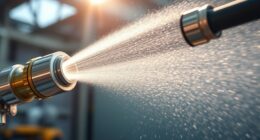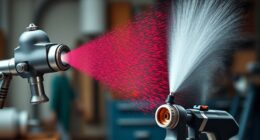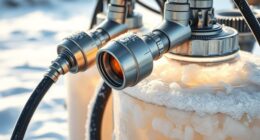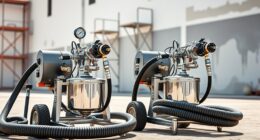Picture yourself completing the painting of a stunning object, whether it be a piece of furniture or a car, and wanting to both safeguard it and enhance its luster. This is where a clear coat becomes essential. Applying a clear coat may seem overwhelming, particularly if you lack the proper tools. This is where I can help; my goal is to guide you through the process of applying a clear coat with an airless electric paint sprayer, a cutting-edge tool for achieving a flawless finish.
In this article, I will guide you through the step-by-step process of preparing the surface, choosing the right clear coat, setting up your paint sprayer, and achieving a professional-quality finish. We’ll cover everything from practicing on a test surface to checking for imperfections and cleaning your sprayer afterwards.
By the end, you’ll have the knowledge and confidence to tackle any clear coating project with ease.
So, let’s dive in and learn how to achieve that showroom-worthy finish you’ve always dreamed of.
Key Takeaways
- Technique for even application: Follow recommended movement pattern, maintain consistent distance and parallel sprayer to surface, overlap each stroke by 50%.
- Applying multiple coats: Allow each coat to dry completely before applying the next, apply additional coats for desired glossiness and durability.
- Allowing sufficient drying time: Check manufacturer’s instructions, set up a well-ventilated area with good air circulation, avoid rushing for a smooth and professional finish.
- Achieving desired glossiness: Apply additional coats as needed, layering paint allows for easy control of glossiness, avoid imperfections with multiple thin coats.
Prepare the Surface
Now it’s time to get your surface smooth and ready for a flawless clear coat, so you can feel that satisfying sense of accomplishment when you see the final result. To achieve this, proper preparation techniques are essential.
Begin by thoroughly cleaning the surface to remove any dirt, dust, or debris. Use a mild detergent and water solution, and scrub the surface with a soft brush or sponge. Rinse it thoroughly and allow it to dry completely.
Next, inspect the surface for any imperfections such as scratches or dents. Fill them in with a suitable filler and sand it down until smooth. This step is crucial for achieving a professional finish.
With the surface prepared, you can now move on to the next section about choosing the right clear coat.
Choose the Right Clear Coat
First, make sure you’ve chosen the perfect protective shield for your masterpiece. A glossy armor that will make your project shine like a diamond is what you’re looking for. Choosing the right clear coat is crucial for achieving a professional-looking finish. Here are some tips for applying clear coat effectively:
- Consider the type of surface you’re working with, as different clear coats are designed for specific materials.
- Look for a clear coat that offers UV protection to prevent fading and yellowing over time.
- Opt for a clear coat with a fast drying time to minimize the risk of dust or debris settling on the surface.
- Check the clear coat’s compatibility with the base coat you’ve used to ensure they work well together.
- Read reviews and consult experts to determine the durability and long-term performance of the clear coat.
Once you’ve chosen the right clear coat, you’ll be ready to set up your paint sprayer and start creating a flawless finish.
Set Up Your Paint Sprayer
Get ready to unleash your artistic vision with the power of a high-performance paint sprayer, setting up an experience that will leave you feeling empowered and excited to transform any surface into a work of art. When it comes to achieving a smooth finish with your clear coat, there are a few tips and tricks that can make all the difference. First, make sure to properly thin your clear coat according to the manufacturer’s instructions to ensure optimal spraying. Secondly, set the air pressure on your paint sprayer to the recommended level for clear coats, usually around 40-60 PSI. Lastly, take your time and apply thin, even coats, allowing each coat to dry before applying the next. Common mistakes to avoid include spraying too quickly, which can result in drips and runs, and not cleaning your sprayer thoroughly between coats. By following these tips, you’ll be well on your way to achieving a flawless finish. Now, let’s move on to the next step and practice on a test surface to perfect your technique.
Practice on a Test Surface
Before diving into the project, it’s important to practice using the paint sprayer on a test surface.
I recommend using a scrap piece of material to get a feel for the sprayer and understand how it operates.
This will allow me to adjust the settings as needed to achieve the desired coverage and ensure a smooth and professional finish.
Use a scrap piece of material to get a feel for the sprayer
To really get the hang of using the airless electric paint sprayer, grab a scrap piece of material and let the fun begin! Practicing on a test surface is essential to hone your skills and become familiar with the sprayer’s behavior. By doing so, you can experiment with different techniques and troubleshoot any potential issues that may arise.
To make the most out of your practice session, I suggest using a 3 column and 5 row table to track your progress. In the first column, list the various techniques you want to try, such as horizontal strokes, vertical strokes, or circular motions. In the second column, record your observations about the spray pattern, coverage, and any difficulties you encounter. Finally, in the third column, note down any adjustments you make to the sprayer settings to improve the results.
By practicing and analyzing your results, you’ll gain valuable insights into how the airless electric paint sprayer operates and how to achieve the desired coverage. Once you feel confident with your technique, you can move on to the next step of adjusting the settings as needed to achieve the desired coverage.
Adjust the settings as needed to achieve the desired coverage
To achieve the desired coverage, you can adjust the settings as needed. Here are some tips to keep in mind when using an airless electric paint sprayer:
-
Adjust the pressure: Start with a low pressure setting and gradually increase it until you achieve the desired coverage. This will help prevent excessive overspray and ensure an even coat.
-
Control the fan width: The fan width determines the size of the spray pattern. Narrow the fan width for smaller areas or increase it for larger surfaces. Adjusting this setting allows for more precise application.
-
Watch for uneven spraying: If you notice any unevenness in the coat, adjust the distance from the sprayer to the surface. Holding the sprayer too close can result in a concentrated spray, while holding it too far away can lead to a thin coat.
By using these adjusting techniques and troubleshooting tips, you can achieve professional results when clear coating with an airless electric paint sprayer.
Now, let’s move on to the next section and start spraying.
Start Spraying
When starting to spray with an airless electric paint sprayer, it’s crucial to hold the sprayer at a consistent distance from the surface. This ensures that the paint is evenly applied and prevents any streaks or uneven coverage.
Moving in smooth, overlapping strokes is also essential to achieve a professional finish. By following these key points, I can ensure that my paint job is precise and detailed, resulting in a smooth and even coat on the surface.
Hold the sprayer at a consistent distance from the surface
To achieve a consistent spraying technique and maintain the correct nozzle pressure, it is crucial to hold the sprayer at a steady distance from the surface. Here are four important tips to help you achieve this:
-
Set the distance: Start by holding the sprayer approximately 12 inches away from the surface. Refer to the user manual for manufacturer’s recommendations on the ideal distance.
-
Keep it steady: Once you’ve determined the ideal distance, maintain it throughout the entire application process. This ensures an even coat and prevents inconsistencies in the finish.
-
Watch your speed: Avoid moving the sprayer too quickly or too slowly. Find a comfortable pace that allows you to cover the surface evenly without rushing or lingering in one spot for too long.
-
Practice makes perfect: If you’re new to using an airless electric paint sprayer, practice on a scrap piece of material before starting your project. This helps you get a feel for the sprayer and refine your technique.
Now, let’s move on to the next step: moving in smooth, overlapping strokes to ensure even coverage.
Move in smooth, overlapping strokes to ensure even coverage
Gliding the sprayer in fluid, overlapping motions ensures a seamless and flawless distribution of the clear coating. To achieve a smooth application and an even finish, it is crucial to move the sprayer in a consistent and controlled manner. By following this technique, you can avoid streaks, drips, and uneven coverage.
To help you visualize the process, here is a table outlining the recommended movement pattern:
| Stroke 1 | Stroke 2 | Stroke 3 |
|---|---|---|
| Left to right | Top to bottom | Diagonal |
Make sure to maintain a consistent distance from the surface and keep the sprayer parallel to it. Overlapping each stroke by about 50% will ensure that the coating is evenly distributed. This technique allows for better control and coverage, resulting in a professional-looking finish.
Now that you have achieved an even application with your first coat, let’s move on to the next step of applying multiple coats.
Apply Multiple Coats
When applying multiple coats of clear coat using an airless electric paint sprayer, it is important to allow each coat to dry completely before applying the next. This ensures that each layer adheres properly and prevents any issues with bubbling or peeling.
Additionally, it is recommended to apply additional coats as needed to achieve the desired level of glossiness. By following these steps, you can achieve a smooth and professional finish for your project.
Allow each coat to dry before applying the next
Once the previous coat has dried, you can proceed to apply the next coat using an airless electric paint sprayer. Allowing sufficient drying time between coats is crucial to achieving a smooth and professional-looking finish. Here are some tips for ensuring the best results:
- Check the manufacturer’s instructions for the recommended drying time. This can vary depending on factors such as temperature and humidity.
- Avoid rushing the process and give each coat ample time to dry completely. This will help prevent any issues like bubbling or peeling.
- If possible, set up a well-ventilated area with good air circulation to speed up the drying process.
| Tips for Allowing Sufficient Drying Time | ||
|---|---|---|
| Check manufacturer’s instructions | Avoid rushing | Ensure good air circulation |
By following these guidelines, you will ensure that each coat dries properly and creates a strong foundation for the next application. Once the desired level of glossiness is achieved, you can move on to applying additional coats as needed.
Apply additional coats as needed for the desired level of glossiness
To achieve the desired level of glossiness, apply additional coats of paint as needed. Adding more coats enhances the depth of the finish, making it appear richer and more vibrant. It also increases the durability and longevity of the finish, providing extra protection against scratches, UV rays, and other environmental factors. By carefully layering the paint, you can achieve a professional-quality shine that gives your project a polished appearance. Applying multiple thin coats allows you to easily control the glossiness level and avoid imperfections. Now, let’s move on to the next section and check for any possible flaws or imperfections in the finish.
Check for Imperfections
Inspect the surface for any flaws before proceeding to apply the clear coat with the airless electric paint sprayer. It is important to check for imperfections such as bubbles or unevenness, as these can affect the final result of your clear coat. To ensure a smooth finish, there are techniques you can use, such as sanding any rough spots and using a tack cloth to remove any dust or debris.
To help you understand the importance of inspecting the surface, here’s a table that highlights common imperfections and how to address them:
| Imperfection | Solution |
|---|---|
| Bubbles | Sand the affected area lightly and reapply clear coat. |
| Unevenness | Sand the surface evenly and apply an additional coat if necessary. |
| Dust or debris | Use a tack cloth to remove any particles and apply clear coat carefully to avoid trapping more debris. |
Once you have checked for imperfections and addressed them accordingly, you can proceed to clean and maintain your paint sprayer to ensure its longevity and optimal performance.
Clean and Maintain Your Paint Sprayer
Make sure to take good care of your trusty paint sprayer by regularly cleaning and maintaining it. Cleaning your paint sprayer is essential to ensure optimal performance and longevity.
After each use, thoroughly clean the sprayer by flushing it with water or a cleaning solution, depending on the type of paint used. Pay special attention to the nozzle, filter, and other components to remove any paint residue.
Regularly inspect and replace worn-out parts, such as seals and gaskets, to prevent leaks and maintain a proper spray pattern. Troubleshooting common issues, such as clogged nozzles or inconsistent spray, can also be resolved by cleaning or adjusting the sprayer.
By following these cleaning tips and regularly maintaining your paint sprayer, you can ensure it continues to deliver flawless results.
Now, let’s move on to allowing the clear coat to cure.
Allow the Clear Coat to Cure
I can’t stress enough the importance of giving the clear coat ample time to dry and cure. It may be tempting to touch or disturb the surface, but it’s crucial to resist that urge until it is fully cured.
This will ensure a flawless finish and prevent any potential damage or imperfections.
Give the clear coat ample time to dry and cure
Once you’ve applied the clear coat with your airless electric paint sprayer, it’s important to give it ample time to dry and cure. Just like waiting for a cake to bake to perfection, patience is key. Here are a few tips and methods for speeding up the drying process:
-
Increase airflow: Promote air circulation by using fans or opening windows. This will help the clear coat dry faster.
-
Use a heat source: Gently warm the clear coat with a heat gun or infrared lamp. This will accelerate the drying time.
-
Apply thin coats: Thick layers of clear coat take longer to dry and are more prone to bubbles. To avoid this, apply multiple thin coats.
By following these methods, you can speed up the drying process and prevent clear coat bubbles. Once the clear coat is fully cured, you can proceed with the next steps without worrying about touching or disturbing the surface.
Avoid touching or disturbing the surface until it is fully cured
Be patient and resist the temptation to touch or disturb the surface until it’s fully cured. This ensures a flawless and professional finish that you’ll be proud to show off. Avoiding mistakes during the curing process is crucial for achieving a smooth and long-lasting clear coat.
Once you have applied the clear coat with your airless electric paint sprayer, let it dry undisturbed for the recommended amount of time. This typically ranges from 24 to 48 hours, but it’s always best to refer to the manufacturer’s instructions for specific guidance.
During this time, keep the area free from dust, debris, and any potential sources of damage.
By following these tips for a smooth finish, you’ll be rewarded with a professional-quality result that will make your project shine.
In the next section, we’ll discuss how to enjoy your professional-quality finish without any additional steps.
Enjoy Your Professional-Quality Finish
Achieve a flawless, glossy finish that will make your project look like it was done by a professional with the help of an airless electric paint sprayer.
When it comes to clear coat application techniques, it is important to follow a few key steps to ensure a professional finish.
First, make sure the surface is clean and free of any debris or dust.
Next, apply the clear coat in thin, even layers, using smooth, controlled strokes.
Allow each layer to dry completely before applying the next one. This will help prevent any drips or unevenness in the finish.
Finally, be patient and avoid touching or disturbing the surface until it is fully cured.
This will ensure a smooth and flawless finish that will make your project look like it was done by a professional.
Frequently Asked Questions
Can I use any type of clear coat with an airless electric paint sprayer?
Using any type of clear coat with an airless electric paint sprayer has its pros and cons. The key to achieving a smooth and even finish is to properly prepare the surface, use the right tip size, and maintain a consistent spraying technique.
How long does it take for the clear coat to cure?
The clear coat typically takes around 24 to 48 hours to dry completely. To speed up the curing process, you can increase ventilation, use a dehumidifier, or apply heat with infrared lamps or heat guns.
Can I apply the clear coat directly on top of the previous paint job?
Yes, you can apply the clear coat directly on top of the previous paint job. However, it is essential to prepare the surface properly by cleaning and sanding it. Additionally, ensure proper ventilation to allow the clear coat to dry and cure effectively.
Are there any safety precautions I need to take when using an airless electric paint sprayer?
When using an airless electric paint sprayer, it is important to wear a respirator and ensure proper ventilation to protect against harmful fumes. For example, I once painted a room without proper ventilation and experienced dizziness and headaches.
How do I clean the paint sprayer after I finish using it?
To clean the paint sprayer after use, follow this cleaning process. First, disconnect the sprayer from the power source. Then, remove the paint container and rinse it thoroughly. Lastly, clean the nozzle and filter to prevent clogging. Common mistakes include not cleaning the sprayer immediately after use and neglecting to clean all parts thoroughly.
Conclusion
In conclusion, using an airless electric paint sprayer to apply a clear coat can result in a professional-quality finish for your project. With proper preparation, the right clear coat, and careful spraying technique, you can achieve a flawless and durable coating.
One interesting statistic to note is that according to a study conducted by the Paint Quality Institute, using a paint sprayer can save up to 50% of the time compared to traditional brush or roller methods.
So why not give it a try and experience the efficiency and precision of an airless electric paint sprayer for yourself?










